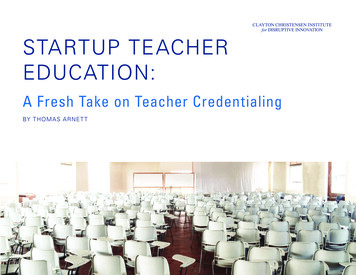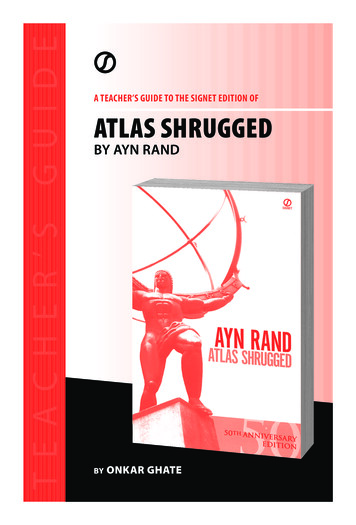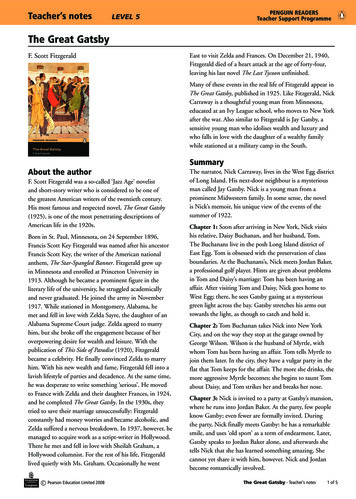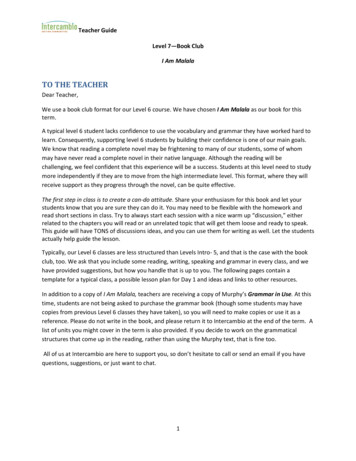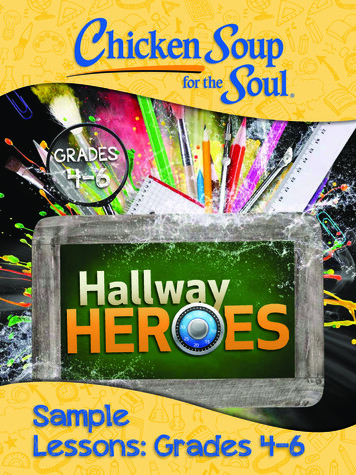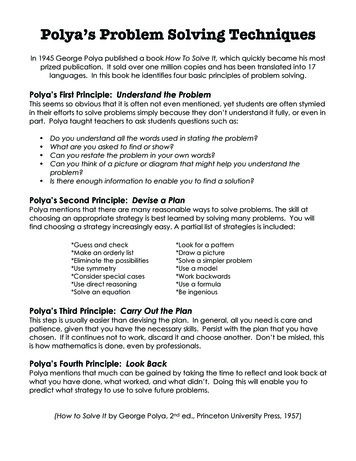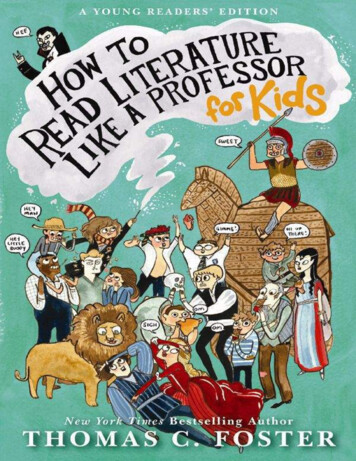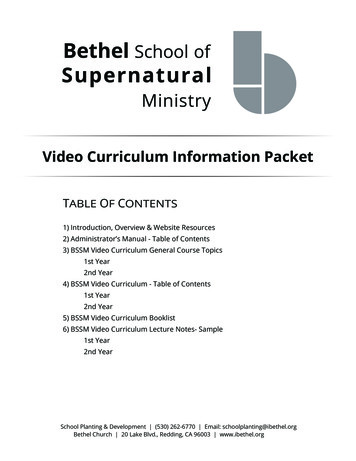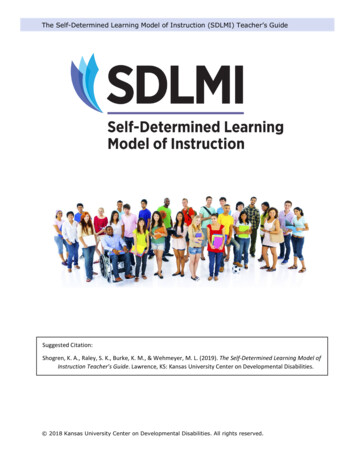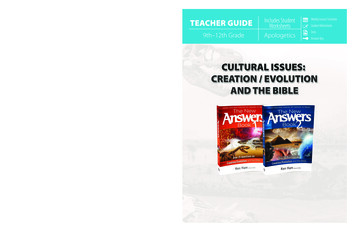
Transcription
A TEACHER’S RESOURCE forPART OF THE “WITNESSES TO HISTORY” SERIES PRODUCED BYFACING HISTORY AND OURSELVES & VOICES OF LOVE AND FREEDOM
A TEACHER’S RESOURCE forNightby Elie WieselPart of the “Witnesses to History” series produced byFacing History and Ourselves & Voices of Love and Freedom
AcknowledgmentsVoices of Love and Freedom (VLF) is a nonprofit educational organization that promotes literacy, values, and prevention. VLF teacher resources are designed to helpstudents: appreciate literature from around the world develop their own voices as they learn to read and write learn to use the values of love and freedom to guide their lives and live healthy lives free of substance abuse and violence.Voices of Love and Freedom was founded in 1992 and is a collaboration of the JudgeBaker Children’s Center, Harvard Graduate School of Education, City University ofNew York Graduate School, and Wheelock College.For more information, call 617-635-6433, fax 617-635-6422,e-mail VLFBOSTON@aol.com, or write Voices of Love and Freedom,67 Alleghany St., Boston, MA 02120.Facing History and Ourselves National Foundation, Inc. (FHAO) is a national educational and teacher training organization whose mission is to engage students ofdiverse backgrounds in an examination of racism, prejudice, and antisemitism inorder to promote the development of a more humane and informed citizenry. Bystudying the historical development and lessons of the Holocaust and other examples of genocide, students make the essential connection between history and themoral choices they confront in their own lives.For more information, contact FHAO, National Office, 16 Hurd Road, Brookline, MA 02445; 617-232-1595; http://www.facing.org.FHAO Guide Review Committee: Fran Colletti, Jan Darsa, Phyllis Goldstein,Marc Skvirsky, Margot Stern Strom.Harcourt General Charitable Foundation, Inc. has awarded a grant to VLF andFHAO to jointly produce teacher resources for the secondary grades. Other fundersof this unique project include the following organizations: The Boston Company,Carnegie Corporation of New York, Facing History and Ourselves Young LeadershipNetwork, New England Hi-Tech Charity Foundation, Parametric Technology Corporation, the Surdna Foundation, and The TJX Companies, Inc.Teacher Resource Writers: Pat Walker, Director of VLF, and Phyllis Goldstein,FHAO, with assistance from Jan Darsa, FHAODesign and Production: Lolly Robinson, interior; Jenifer Snow, coversThis teacher resource is based on the following edition: Night by Elie Wiesel, Bantam Books, 1986, 25thAnniversary Edition.Teacher Resource 1999 Voices of Love and Freedon, Inc. and Facing History and Ourselves National Foudation. All rights reserved. Not to be reproduced without permission.iiNightVoices of Love and Freedom Facing History and Ourselves
Table of ContentsWitnesses to History . . . . . . . . . . . . . . . . . . . . . . . . . . . . . . . . . . . . . . . . . . vAbout the Book . . . . . . . . . . . . . . . . . . . . . . . . . . . . . . . . . . . . . . . . . . . . . viiiStory SummaryCritical Responses to the BookAbout the AuthorThe Context of the StoryAbout the Teacher Resource . . . . . . . . . . . . . . . . . . . . . . . . . . . . . . . . . . xivExploring the Central QuestionResource OverviewLiterary AnalysisSocial Skills and ValuesCross Curricular Activities/Facing History and OurselvesReading 1: Defining Identity (pages 1–20) . . . . . . . . . . . . . . . . . . . . . 1To Connect . . . . . . . . . . . . . . . . . . . . . . . . . . . . . . . . . . . . . . . . . . . . . . . . . 1Introduce the Central QuestionTeacher Activity: Who Am I?Partner Activity: Creating Identity BoxesWhole Class Viewing: Introduction to NightWrap-Up SuggestionsTo Read . . . . . . . . . . . . . . . . . . . . . . . . . . . . . . . . . . . . . . . . . . . . . . . . . . . . 4To Discuss . . . . . . . . . . . . . . . . . . . . . . . . . . . . . . . . . . . . . . . . . . . . . . . . . . 4To Practice . . . . . . . . . . . . . . . . . . . . . . . . . . . . . . . . . . . . . . . . . . . . . . . . . 5Partner Activity: Creating Eliezer’s Identity BoxTo Express . . . . . . . . . . . . . . . . . . . . . . . . . . . . . . . . . . . . . . . . . . . . . . . . . . 6Journal SuggestionsRelated Readings and ViewingsReading 2: Initiation to Auschwitz (pages 21–43) . . . . . . . . . . . . . . .8To Read . . . . . . . . . . . . . . . . . . . . . . . . . . . . . . . . . . . . . . . . . . . . . . . . . . . . 8To Discuss . . . . . . . . . . . . . . . . . . . . . . . . . . . . . . . . . . . . . . . . . . . . . . . . . . 9To Practice . . . . . . . . . . . . . . . . . . . . . . . . . . . . . . . . . . . . . . . . . . . . . . . . 11Small Group Activity: Reading for MeaningPartner Activity: Revising Eliezer’s Identity BoxTo Express . . . . . . . . . . . . . . . . . . . . . . . . . . . . . . . . . . . . . . . . . . . . . . . . . 12Journal SuggestionsRelated Readings and ViewingsReading 3: Identity and Indifference (pages 45–62) . . . . . . . . . . . . 14To Read . . . . . . . . . . . . . . . . . . . . . . . . . . . . . . . . . . . . . . . . . . . . . . . . . . . 14To Discuss . . . . . . . . . . . . . . . . . . . . . . . . . . . . . . . . . . . . . . . . . . . . . . . . . 14To Practice . . . . . . . . . . . . . . . . . . . . . . . . . . . . . . . . . . . . . . . . . . . . . . . . 16Whole Class Discussion: Stories of AuschwitzVoices of Love and Freedom Facing History and OurselvesNightiii
To Express . . . . . . . . . . . . . . . . . . . . . . . . . . . . . . . . . . . . . . . . . . . . . . . . . 17Writing Activity: A Letter to Elie WieselJournal SuggestionsRelated Readings and ViewingsReading 4: Faith and Survival at Auschwitz (pages 63–80) . . . . . . 19To Read . . . . . . . . . . . . . . . . . . . . . . . . . . . . . . . . . . . . . . . . . . . . . . . . . . . 19To Discuss . . . . . . . . . . . . . . . . . . . . . . . . . . . . . . . . . . . . . . . . . . . . . . . . . 20To Practice . . . . . . . . . . . . . . . . . . . . . . . . . . . . . . . . . . . . . . . . . . . . . . . . 21Partner Activity: Rede ning “F ree Words” for an Unfree WorldWhole Class Activity: A Visit to a Holocaust MemorialTo Express . . . . . . . . . . . . . . . . . . . . . . . . . . . . . . . . . . . . . . . . . . . . . . . . . 23Writing Activity: Expressing a Point of ViewJournal SuggestionsRelated Readings and ViewingsReading 5: The Importance of Memory (pages 81–109) . . . . . . . 24To Read . . . . . . . . . . . . . . . . . . . . . . . . . . . . . . . . . . . . . . . . . . . . . . . . . . . 25To Discuss . . . . . . . . . . . . . . . . . . . . . . . . . . . . . . . . . . . . . . . . . . . . . . . . . 25Independent Writing Activity: Reader ResponsesTo Practice . . . . . . . . . . . . . . . . . . . . . . . . . . . . . . . . . . . . . . . . . . . . . . . . 27Whole Class Discussion: It Touches Us AllTo Express . . . . . . . . . . . . . . . . . . . . . . . . . . . . . . . . . . . . . . . . . . . . . . . . . 28Journal SuggestionsFinal Writing Activity: Witness to HistoryRelated Readings and ViewingsTo Participate . . . . . . . . . . . . . . . . . . . . . . . . . . . . . . . . . . . . . . . . . . . . . . 30Community Service Activity: Sharing StoriesAppendicesAppendix A . . . . . . . . . . . . . . . . . . . . . . . . . . . . . . . . . . . . . . . . . . . . . . . . 31Elie Wiesel’s Acceptance Speech for the Nobel Peace PrizeAppendix B . . . . . . . . . . . . . . . . . . . . . . . . . . . . . . . . . . . . . . . . . . . . . . . . 32Timeline of the HolocaustAppendix C . . . . . . . . . . . . . . . . . . . . . . . . . . . . . . . . . . . . . . . . . . . . . . . . 34A Guide to Jewish References in NightReproduciblesReader Responses . . . . . . . . . . . . . . . . . . . . . . . . . . . . . . . . . . . . . . . 36Witness to History . . . . . . . . . . . . . . . . . . . . . . . . . . . . . . . . . . . . . . 37Critiquing Your Draft . . . . . . . . . . . . . . . . . . . . . . . . . . . . . . . . . . . . 38ivNightVoices of Love and Freedom Facing History and Ourselves
Witnesses to HistoryIt has been said that memory is the imprint of the past upon us as individuals and asmembers of a family, an ethnic or religious group, a community, even a nation. Ourmemory is also the keeper of what is most meaningful to our deepest hopes and ourgreatest fears. Voices of Love and Freedom and Facing History and Ourselves havecreated teacher resources for six literary works that focus on individual encounterswith history in ways that deepen our understanding of the connections between pastand present. Each also reveals the importance of confonting history in all of its complexity, including its legacies of prejudice and discrimination, resilience and courage.Voices of Love and Freedom and Facing History and Ourselves have developed ateacher resource for each of the following titles:The Giver by Lois Lowry—a futuristic novel that explores the relationship betweenpast and present, between identity and memory. The Central Question: How doour individual and collective memories shape who we are today and influence ourfutures?Night by Elie Wiesel—a memoir that focuses on the final year of the Holocaust—ayear the author spent at Auschwitz, a Nazi death camp. The Central Question:What is the relationship between our stories and our identity? To what extent are weall witnesses of history and messengers to humanity?Farewell to Manzanar by Jeanne Wakatsuki Houston and James D. Houston—anaccount of a young girl’s experiences at an internment camp in the United Statesduring World War II. It reveals how the time Jeanne Wakatsuki spent at Manzanarshaped her identity—her sense of who she is and what she might become. The Central Question: How do our confrontations with justice and injustice help shape ouridentity? How do those confrontations influence the things we say and do?Warriors Don’t Cry by Melba Pattillo Beals—a first-hand account of the integrationof Central High School in Little Rock, Arkansas, in 1957. The book explores notonly the power of racism but also such ideas as justice, identity, loyalty, and choice.The Central Question: What can we do alone and with others to confront racism?How can we as individuals and as citizens make a positive difference in our school,community, and nation?Kaf r Bo y: The True Story of a Black Youth’s Coming of Age in Apartheid South Africaby Mark Mathabane—a first-person narrative about the impact of racism and segregation on a young black South African in the 1970s. The book can be used to deepenan understand not only of racism but also of such concepts as identity, resilience, andresistance. The Central Question: What are different ways we struggle for freedom?The Joy Luck Club by Amy Tan (coming in fall, 1999).Voices of Love and Freedom Facing History and OurselvesNightv
Teacher ResourcesEach teacher resource is organized around a central theme or question related to thetheme of the work. The following strategies are used to develop the central questionand related ideas and promote literacy and social skills.Central Theme or QuestionWhile several themes from the story are explored in the teacher resource, the centraltheme has been selected to assure that activities build upon one another and providestudents with a deep understanding of a key aspect of the story.To ConnectThe activities in the To Connect sections of the resources are pre-reading activities.They include suggestions for introducing the central theme, using teacher and student stories to encourage a connection with the central theme, discussing key concepts, and providing an historical and conceptual context for understanding the literary work. One of the primary purposes of these activities is to help students toconnect their own personal experience to the issues raised in the story prior to readingthe story.To DiscussAfter reading the story or a section of the story, a variety of discussion questions helpteachers foster a lively conversation that deepens comprehension and widens students’ perspectives. These questions also encourage interpretation of the text anddevelop important concepts as well as reinforce speaking, listening, and criticalthinking skills.To PracticeAfter students have read and discussed a story (or section), a variety of interactiveactivities provide practice in key literacy and social skills. Some of these activitiesinvolve the whole class in reenactments of key scenes, role playing, and debates. Others are partner or individual activities that provide opportunities to practice literacyskills (listening and speaking) and/or social skills (perspective taking and conflict resolution).To ExpressStudents are encouraged to reveal their understanding of the story through the use ofjournals and structured writing activities. These activities help students appreciatethe author’s craft as well as develop their own writing skills. At the end of eachteacher resource, the Final Writing Activity helps students express their understanding of the book and their responses to the Central Question.To ParticipateSome teacher resources contain suggestions for engaging students in community service projects at school, in the home, or in the neighborhood. These activities buildon insights and values developed through reading and discussing the story.viNightVoices of Love and Freedom Facing History and Ourselves
Voices of Love and FreedomVoices of Love and Freedom is a K–12 educational organization that helps studentsappreciate literature from around the world, develop their own voices as they learn toread and write, learn to use the values of love and freedom to guide their lives, andlive healthy lives free of substance abuse and violence.Facing History and OurselvesFacing History and Ourselves is an educational organization that helps teachers andtheir students find meaning in the past and recognize the need for participation andresponsible decision making. By providing an interdisciplinary framework for examining the meaning and responsibilities of citizenship, Facing History expands knowledge, challenges thinking, and stretches students’ imagination.Voices of Love and Freedom Facing History and OurselvesNightvii
About the BookStory SummaryNight is a terse, terrifying account of the experiences of a young Jewish boy atAuschwitz, a Nazi death camp. The book opens in 1941 in his hometown of Sighet,a small isolated community tucked away in the mountains of Transylvania, thenunder Hungarian rule. Eliezer, the narrator, begins with a description of Jewish lifein the town. He also draws a vivid picture of himself and his family. He focuses inparticular on his fascination with his religion, particularly the mystical aspects of hisfaith.In 1941, Europe is in its third year of war. By this time it has become more andmore dangerous to be a European Jew. Yet, despite the news from other countries,the Jews of Sighet refuse to believe that they are at risk. They dismiss the stories ofMoshe the Beadle, a foreign Jew who was deported to German-occupied Poland in1941 along with thousands of other Jews who held foreign passports. After escapingfrom the Germans, Moshe returns to Sighet to alert the Jews to the danger and findsno one is willing to even imagine that he is telling the truth.People prefer to be optimistic. Their optimism lingers even after German soldiers enter the town in the spring of 1944, force the Jews into ghettos, and, eventually, into cattle cars for deportation to Auschwitz-Birkenau in Poland. Among thoseJews are fifteen-year-old Eliezer, his parents, and his sisters. Only when the trainspull into Auschwitz do they begin to realize the horror that lies before them. Thewomen—including Eliezer’s mother and sisters—are immediately separated fromthe men. It was the last time that Eliezer would see his mother and youngest sister.In the weeks that follow, Eliezer and his father are stripped of their clothing,their hair, and ultimately their names. Each is now identified by a number tattooedon his arm. In the months that follow, they endure hunger, humiliation, and a violence beyond cruelty in the various camps that make up Auschwitz-Birkenau,including Buna, a slave labor camp. Then in the winter of 1945, as the Allies close inon the German army, the camp is evacuated. Eliezer, his father, and the other prisoners are forced to travel in winter on foot and in open cattle cars to yet anotherprison camp, this time Buchenwald in Germany. Not long after they arrive, Eliezer’sfather develops dysentery and slowly dies. Three months later, the camp is liberated.After several weeks in a hospital, hovering between life and death, Eliezer gathers thestrength to look at himself in a mirror. He writes, “From the depths of the mirror, acorpse gazed back at me. The look in his eyes, as they stared into mine, has never leftme.” (page 109)Critical Responses to the BookNight was Elie Wiesel’s first book. Written in Yiddish ten years after his liberationfrom Buchenwald, it was originally published under the title And the World HasRemained Silent. In 1958, it was condensed and printed in French as La Nuit, andtranslated into English in 1960 as Night. Wiesel wrote five other books in rapid succession: Dawn (1960), The Accident (1961), The Town Beyond the Wall (1962), TheGates of the Forest (1964), and A Beggar in Jerusalem (1968). In many ways, Night isviiiNightVoices of Love and Freedom Facing History and Ourselves
the starting point for Wiesel’s other books.Robert McAfee Brown, a professor of theology, has called Night the one book byWiesel “that most cries out not to be touched, interpreted, synthesized. It must beencountered first hand.”* Wiesel himself says of the book, “when I wrote it in 1955,while I wrote it, it might have been the only book I would have written. To me itwould have been enough.”** Although the book was favorably reviewed, it did notattract many readers. In the late 1950s and early 1960s, few people were willing toconfront the Holocaust. Today the book has been translated into dozens of languagesand is read by people around the world.About the AuthorElie Wiesel was born in 1928 in Sighet, a border town of about 120,000 people. It isa town with a long and complicated history. After World War I, it was a part of Hungary, then handed over to Romania, and then taken back by Hungary at the beginning of World War II. During the war, the town became part of Hitler’s Third Reich.After the war, it was under Russian rule for a time and then turned over to Romania.Wiesel grew up in the Jewish section of Sighet. His father, Shlomo, was a shopkeeper who was deeply involved in the Jewish community. He wanted his only son(Elie Wiesel had three sisters) to be as practical as he himself was. The boy’s mother,a well-educated woman, encouraged him to be pious. She would have liked for herson to become a rabbi. As a boy, Wiesel felt closer to his mother than his father. Heimmersed himself in religious studies and dreamed of becoming a scholar.Then in March of 1944, the Germans entered Hungary and the boy’s lifechanged forever. Within a month, the Nazis were deporting thousands of Jews fromTransylvania, including about fifteen thousand from Sighet and eighteen thousandfrom neighboring villages. Wiesel, at the age of fifteen, was among those shipped toAuschwitz along with his parents and sisters. There his mother and youngest sisterwere immediately sent to the gas chambers. His two older sisters managed to survive,but he did not know their fate until after the war.Wiesel and his father clung to one another from their arrival at Auschwitz totheir entry into Buchenwald. There his father developed dysentery and died justthree months before liberation.After the war, Wiesel was sent to France along with four hundred other childrefugees. At the border, the children were asked if they wanted to become French citizens. Wiesel, unable to understand the question, did not respond. As a result, he wasstateless until 1963, when he became a U.S. citizen. Over the next few years, Wieselstudied French, continued his Jewish studies, and took classes in philosophy and literature. He supported himself by tutoring in Yiddish, Hebrew, and the Bible.For Wiesel, the French language offered a “new beginning, a new possibility, anew world.” Although he eventually became a reporter who wrote articles in* Robert McAfee Brown, Elie Wiesel, Messenger to All Humanity (University of Notre DamePress, 1983), 51.** Henry James Cargas, Conversation with Elie Wiesel (Justice Books, 1992), 89.Voices of Love and Freedom Facing History and OurselvesNightix
Hebrew, Yiddish, and English (which he learned in 1952 on a trip to India), all of hisbooks except Night have been written in French. And it was a Frenchman who firstencouraged him to tell his story. On one assignment in 1954, he met the FrenchCatholic writer François Mauriac who not only urged the young reporter to writeabout his experiences but also helped him find a publisher. Two years later, Wieselcompleted the first version of Night. After it was condensed and translated from Yiddish into French, Mauriac wrote the foreword.The publication of Night marked the beginning of Wiesel’s literary career. Sincethen, he has written more than thirty-five books. After their marriage in 1968, hiswife, Marion, served as his English translator. The Wiesels live in New York Citywith their son, Elisha. Today Wiesel is not only a writer but also a teacher. He isAndrew W. Mellon Professor in the Humanities and University Professor at BostonUniversity. He is also an observant Jew who continues to be a witness to history. Hehas spoken out repeatedly against injustices wherever they occur in the world. Overthe years, he has received many awards for his work, including the Presidential Medalof Freedom, the United States Congressional Gold Medal, the French Legion ofHonor, and, in 1986, the Nobel Peace Prize. In presenting the award, Egil Aarvik,the chair of the Nobel Committee, said the following of Wiesel:His mission is not to gain the world’s sympathy for the victims or the survivors.His aim is to awaken our conscience. Our indifference to evil makes us partnersin the crime. This is the reason for his attack on indifference and his insistenceon measures aimed at preventing a new Holocaust. We know that the unimaginable has happened. What are we doing now to prevent its happening again?Through his books Elie Wiesel has given us not only an eyewitness accountof what happened, but also an analysis of the evil powers which lay behind theevents. His main concern is the question of what measures we can take to prevent a recurrence of these events.*By the 1990s, Wiesel was expressing his concern by traveling to war-torn countriesto call attention to violations of basic human rights.About the New TranslationElie Wiesel poses the question in the Preface to the new translation by MarionWiesel, his wife and longtime translator, “Why this new translation, since the earlierone has been around for forty-five years?” His response is simple. Because he was anunknown author who was just getting started, he was simply pleased that his storywas finally being published. He recalls thinking the original British translator’s version of his memoir “seemed all right,” but admits to never rereading it until now.Wiesel writes, “And so, as I reread this text written so long ago, I am glad that I didnot wait any longer. And yet, I still wonder: Have I used the right words?”* Egil Aarvik, “The Nobel Peace Prize, 1986” (Sweden, 1986).xNightVoices of Love and Freedom Facing History and Ourselves
What does Wiesel’s question open up for teachers and students to discuss in theclassroom? What are the “right words” to express and document one’s experience inthe camps? In the opening of the new Preface, Wiesel begins to respond to thisimportant question by stating,In retrospect I must confess that I do not know, or no longer know, what Iwanted to achieve with my words. I only know that without this testimony, mylife as a writer—or my life, period—would not have become what it is: that ofa witness who believes he has a moral obligation to try and prevent his enemyfrom enjoying one last victory by allowing his crimes to be erased from humanmemory.The Context of the StoryMuch of Night takes place within a single year, 1944–1945. It was the final year ofwhat later became known as the Holocaust, a Greek word that means “completedestruction by fire.” Between 1933 and 1945, Adolf Hitler and his followers murdered about one-third of all the Jews in the world. Young and old alike were killedsolely because of their ancestry.Roots of AntisemitismScholars are still debating why the Jews were singled out for destruction. Historianshave traced negative feelings about Jews back over two thousand years to the time ofthe Roman Empire and the beginnings of Christianity. Jesus lived as a Jew in Palestine at a time of crisis. After the Romans conquered the country, they insisted thatthe Jews not only obey Roman laws but also worship Roman gods just as other conquered people did. When Jews refused to do so, they were labeled “stubborn,” “clannish,” and “hostile.” As pressure to accept Roman culture mounted, Jews searcheddesperately for a way to maintain their religious identity. Some urged open rebellionagainst Rome. Others, including Jesus, argued for peace.As each side marshaled arguments in defense of its position, the debate increasedin intensity. Still, all of the attacks and counterattacks took place within the contextof Judaism. Only when Jesus’s disciples separated themselves from Judaism, did theirwords take on new meaning. They became, in the words of Krister Stendahl, a professor of Christian Studies, “missiles hurled from a mainly gentile Church toward theSynagogue across the street, from which now those Jews who followed Jesus hadbeen excommunicated. And by that shift Christian anti-Judaism was born.” He goeson to say that much has been written about why and how the parting of ways happened, but no one factor was decisive. But once the division was established, boththe Church and the Synagogue “felt the necessity to define themselves by sharpeningtheir differences” even though the two faiths are more alike than they are different.As a result, each came to regard the other as not only different but also suspicious,Voices of Love and Freedom Facing History and OurselvesNightxi
even dangerous.*As a small minority in Europe, Jews were particularly vulnerable to attacks by theChristian majority. By the sixteenth century, many were totally isolated from theirChristian neighbors. In a number of countries, people of the Jewish faith were confined to ghettos, sections of a city or town enclosed by high walls and guarded byChristian gatekeepers. With more rigid separation came new myths and misinformation. Jews and other minorities were increasingly portrayed as agents of the devilresponsible for every catastrophe, from random crime to plague and drought. Peoplehad moved from fearing those they did not know to regarding them as the enemy.Race and AntisemitismBy the 1700s and 1800s, even as the walls of the ghettos were coming down, a newidea was reviving the old myths and misinformation. That idea was race. Until the1800s, the word referred mainly to people who shared a nationality or were related toone another in some way. Now many scientists used the term race to refer to thosewho shared a genetic heritage. Some were so certain that “race” explained all of thecultural differences they observed in the world that they distorted facts or madeclaims they could not substantiate. Many even ranked the “races.” At the top werethe “Aryans,” a mythical people that left India in the distant past and carried its language and culture westward.A number of people took pride in tracing their ancestry to the “Aryans.” Increasingly, these Europeans and Americans believed that, as the descendants of the“Aryans,” they were superior to other “races,” including the Jewish or “Semitic race.”In the past, Jews were targeted for discrimination because of their religious beliefs.Now they were excluded because of their “race.” Antisemitism, which literally means“against Semites,” was coined specifically to describe this new hatred of Jews.Scientists who showed the flaws in racist thinking were ignored. In the late1800s, the German Anthropological Society tried to determine whether there reallywere racial differences between Jewish and “Aryan” children. After studying nearlyseven million students, the society concluded that the two groups were more alikethan different. Historian George Mosse notes that the survey had surprisingly littleimpact: “The idea of race had been infused with myths, stereotypes, and subjectivities long ago, and a scientific survey could change little. The idea of pure, superiorraces and the concept of a racial enemy solved too many pressing problems to be easily discarded.”**By the early 1900s, “race” had become the distorted lens through which toomany people viewed the world. And as racist thinking became “respectable,” attacksagainst Jews and other minorities intensified. These attacks were particularly virulentin times of stress and uncertainty, like the worldwide depression that began in thelate 1920s and early 1930s. At such times, having a “racial enemy” who can beblamed for society’s problems offers an easy answer to complex problems.*Krister Stendahl, “Can Christianity Shed Its Anti-Judaism?” Brandeis Review (Spring 1992), 26.**George Mosse, Toward the Final Solution: A History of European Racism (Fertig, 1978).xiiNightVoices of Love and Freedom Facing History and Ourselves
In 1933, for example, a Protestant minister in Germany wrote, “In the last fifteen years in Germany, the influence of Judaism has strengthened extraordinarily.The number of Jewish judges, Jewish politicians, Jewish civil servants in influ
Dec 11, 1986 · gation on a young black South African in the 1970s. The book can be used to deepen an understand not only of racism but also of such concepts as identity, resilience, and resistance. The Central Question: What are different ways we struggle for freedom? The
